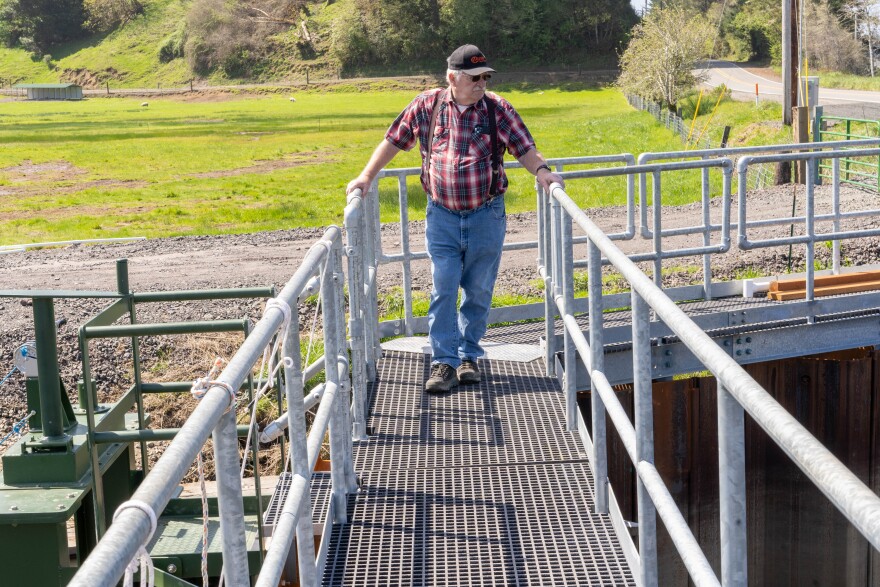On an early spring day outside of North Bend in Coos County, Fred Messerle admires a newly built tide gate spanning Palouse Creek.
The structure protects hundreds of acres — split up between dozens of landowners — from tidal flooding. On one side of the county road, where Messerle is standing, is an inlet of Coos Bay. On the other side are grazing sheep, totally oblivious to the effort it took to keep their pasture above water.
Messerle’s family has made their living off the land along the Southern Oregon coast for the last seven generations.
“We're pretty proud of the fact and take our stewardship of the ground and the land real seriously,” Messerle said.
He sees this unassuming piece of infrastructure as part of that stewardship mission.
How tide gates work
A tide gate is like a big one-way door on a river or creek that feeds into the ocean. High tide will push the door closed, protecting pastures and crops from saltwater. When the water recedes during low tide, the door swings open to let fresh water drain into the ocean.
Coos County is home to about a third of the tide gates in Oregon. Most were put in around 70 years ago, quickly and cheaply, so that families like the Messerles could use the coastal land for pasture or crops. The original tide gate on Palouse Creek was built in the 1950s, Messerle said, and was starting to fail. The gate was leaking, putting upstream pastures at risk.

The drainage district finished the new tide gate last year. It’s made up of four, 10-foot-wide doors and a muted tidal regulator — a feature that keeps the gates open longer so fish can pass. It also lets in just enough saltwater to boost water quality upstream. It’s state-of-the-art in the world of tide gates.
But new technology brings another challenge: a higher price tag.
“When they were put in, a lot of them at the same time, they were way cheaper. You know, they just put in a massive, heavy, top-hinge slab of wood,” said Haley Lutz, executive director at the Coos Watershed Association. “Now you're seeing things that are much more expensive."
The tide gate on Palouse Creek cost around $3 million, which was paid for by state conservation grants. But that’s just the start. There are ongoing costs, too. “These systems are pretty complex,” Messerle said. You can’t just build it and walk away without maintenance, he explained. “It's got a whole bunch of different facets to it.”
Replacing tide gates is a lengthy, complicated process
Installing new tide gates doesn’t just take money, it takes time and patience. “We were working for, well, almost over 30 years to try to get a new structure built,” Messerle said.
One reason for that is the daunting regulatory process.
“There's like anywhere from nine to 11 agencies involved in permitting a single tide gate upgrade,” Lutz said. “It’s a big, multi-jurisdictional problem.”
The site of a tide gate can include confusing overlays of private, state and county land. The original tide gate on Palouse Creek was owned by the Haynes Drainage District but attached to a county bridge. So, just figuring out who had permission to alter the structure took effort.
In 2017, the Oregon Watershed Enhancement Board and the Association of Oregon Counties created the Oregon Tide Gate Partnership to study barriers to repairing and replacing tide gates. That partnership inventoried tide gates in the state, worked to streamline regulations and better coordinated grants. But it can still be a difficult process to replace a tide gate.
There are also more regulations meant to help fish, like the endangered coho salmon, move through these waterways. A tide gate that doesn’t open wide enough might block passage or cause harmful pressure for fish.
“Have you ever put your thumb over like the end of a hose and you see that velocity just kind of spray out and around? It kind of does that whenever it pushes open,” explained Allison Tarbox, a project manager with the Coos Watershed Association.
She said aging tide gates are more likely not to work properly, putting fish at risk. And the situation is getting pretty dire, according to Tarbox.
“Since they were all kind of installed at the same time, they're all kind of failing all at the same time,” she said.
Tide gates protect against rising seas
Climate change makes those tide gates even more crucial. Scientists predict that waters will rise at least 3 feet along the Oregon coast in the next 80 years.
Flooding due to a failing tide gate isn’t only a problem for farmers, explained Fred Messerle. For example, an overflowing Palouse Creek could impair a vital county road.

“You wouldn't be able to get to work or get home again,” Messerle said.
Tide gates aren’t just located in rural and remote areas. Flooding might impact emergency services and inundate lowland buildings in cities like Coos Bay and Coquille.
What frustrates Messerle is that a solution already exists that can satisfy everyone from conservationists to farmers: new tide gates that can protect fish, farmland and infrastructure all at once.
“We've learned so much in the last 20 (or) 30 years,” Messerle said.
The problem isn’t the technology. It’s the cost and the tangle of regulations that slow everything down.
Messerle says Coos County and its tide gates can’t afford to wait another three decades.



